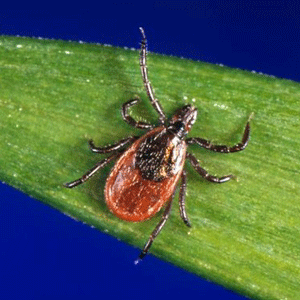Don’t Put Off Removing That Tick!
By Chris Williams on May 11, 2013.
 Question
Question
I’m having an argument with my cousin about the right way to remove an attached tick. He says that if you cover the tick with liquid dish soap, it will smother and die, and then it’s easy to remove. I say that you are supposed to touch it with a hot needle which will cause it to release. What’s your professional opinion?
Answer
In my opinion, you are both wrong. But it’s not just me. Experts say that you shouldn’t do anything to stress the tick because that can cause it to regurgitate saliva, which might contain disease organisms, into the bite. If I were a tick, I think your removal measures would upset me. The Centers for Disease Control does not recommend any tick removal method that relies on the tick detaching on its own because the most important thing to remember about removing an attached tick is immediacy.
Don’t Delay The Removal
It takes a little time for an infected, attached tick to transmit a disease to its host—but you can’t put off removing a tick. After 24 hours, the chance of Lyme disease transmission from an attached blacklegged tick (aka the deer tick) goes up significantly, and is even higher after 48 hours. This is why it’s important to conduct tick checks right after someone has been outside in a tick area. If you wait until you notice the tick the next evening in the shower, that tick may already have been attached for 36 hours.
How to Get It Out
The accepted way to remove an attached tick is to gently pull it out using a pair of pointed tweezers or forceps. First, dip the tweezers in rubbing alcohol. Grab the tick as close to the skin as possible; try to grab the tick’s head and mouth, not the abdomen. You want to be able to pull out all of the tick’s mouthparts. If you jerk or twist the tick, the mouthparts can break off still in the skin. Pull slowly and steadily away from the insertion point until the tick is loose. If any mouthparts are left in the skin, try to remove those as well.
You’re Not Done Yet
Apply an antiseptic to the bite area and wash your hands and the tweezers. We take these precautions because ticks can be carrying disease and you don’t want to get any of their bodily fluids into a cut or abrasion. For that same reason, don’t try to crush the tick. It’s a good idea to save the tick in a little bottle of alcohol just in case it needs to be tested for disease. Using a pencil, write down the date of the bite, the date and time of the tick’s removal, and the body location of the bite on a slip of paper and drop that in the bottle. If the person develops a rash or illness later, see a physician and bring along the bottle with the tick and information.